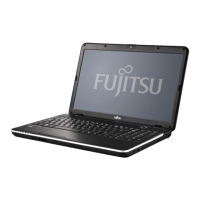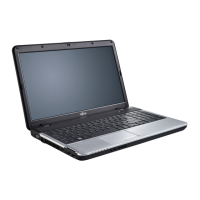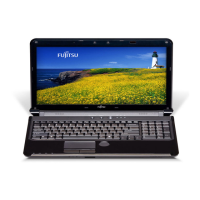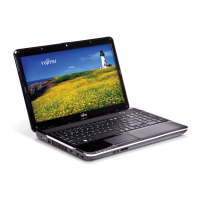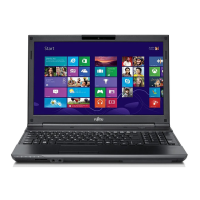Working with the no tebook
LCD screen
LCDscreenNotes
High-quality LCD screens (TF T) are installed in Fujitsu noteboo ks. For technical reasons,
these screens are manufactured for a particular resolution. An optimum a nd sharp image can
only be ensured with the resolution intended for th e particular screen. A screen resolution
which differs from the specification can r esu lt in an unclear image.
The resolution of your notebook’s screen is set to the optimum at the factory.
Current pro duct ion technology cannot guarantee an absolutely fau lt-free screen display. A
few isolated constantly lit or unlit pixels may be present. The maximum p ermitted number of
faulty pixels is stipulated in the international standard ISO 9241-307 (Class 4).
Example:
A screen with a r eso lution of 1280 x 800 has 1280 x 800 = 102400 0 pixels. Each pixel consists of
three subpixels (red, green and blue), so there are almost 3 million subpixels in total. According to ISO
9241-307 (class 4), a maximum of 2 light and 2 dark pixels and in addition 5 light or 10 d ark subpixels
or an equivalent mix (1 light subpixel counts as 2 dark subpixels) are allowed to be defective .
Pixel
A pixel con sists of 3
subpixels, normally red, green and
blue. A pixel is the s
mallest element that can be generated
by complete functi
onality of th e display.
Subpixel
A s ubpixel is a sep
arately addressable internal structure
within a pixel tha
t enhances the pixel function.
Cluster A cluster contains two or more defective pixels or
subpixels in a 5 x 5 pixel b lock.
Background li
ghting
LCD screens ar
e operated with background lighting. The luminosity of the background
lighting can
decrease during the period of use of the notebook. However, you
cansetthebr
ightness of your screen individually.
Synchronis
ing the display on the LCD screen and an external m o nitor
For more in
formation, please refer to the chapter "
Key combinations", Page 24
under "Dis
play output, s witch between".
28 Fujitsu

